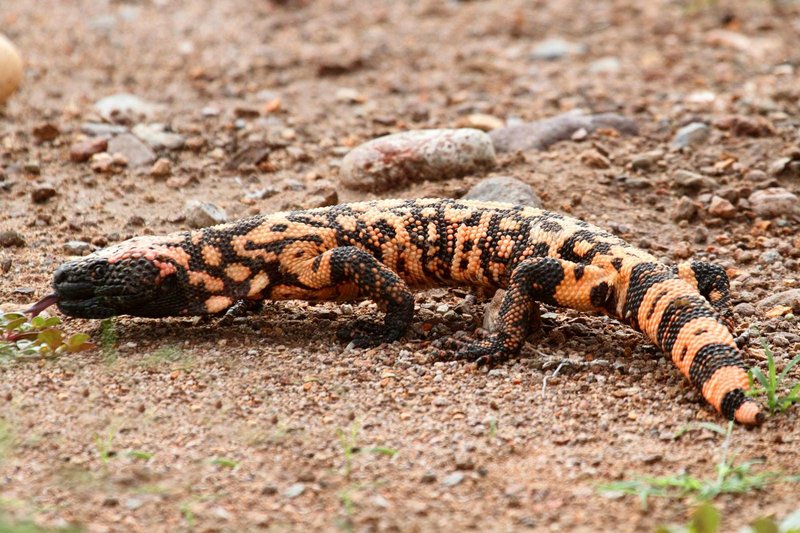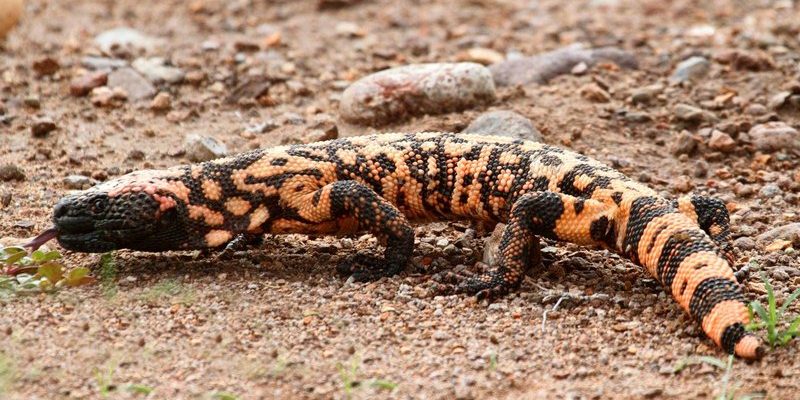
The Gila monster calls the arid deserts of the Southwestern United States and parts of Mexico its home. It might seem like a harsh place to live, but this lizard has adapted in ways that are both clever and unique. Let’s take a closer look at how the Gila monster manages to survive in a world that’s hot, dry, and often unforgiving.
Its Amazing Adaptations
Gila monsters have several adaptations that allow them to thrive in harsh environments. One of the most notable features is their thick, scaly skin. Unlike your average lizard, their skin is designed to reduce water loss. Just think about it: in a desert, water is life, and this lizard has mastered the art of conservation. Its skin is covered in small, bumpy scales that help to retain moisture, making it less vulnerable to the scorching sun.
Another key adaptation is its body temperature regulation. Gila monsters are ectothermic, meaning they rely on external sources of heat to warm up. They love to bask in the sun during cooler mornings but retreat to underground burrows during the hottest parts of the day. This smart behavior keeps them from overheating and saves energy when it’s too hot outside.
You might be wondering why this matters. Well, by balancing their time between basking and hiding, Gila monsters ensure they stay hydrated and don’t exhaust themselves. This clever approach to temperature management is crucial for their survival in such an extreme habitat.
Feeding Habits That Make Sense
When it comes to food, Gila monsters are opportunistic eaters, which means they’ll consume whatever is available. Their primary diet consists of eggs, small mammals, birds, and even other reptiles. What’s fascinating is how their slow metabolism allows them to go for days, sometimes even weeks, without food. That’s right—while we might feel hangry after just a few hours, a Gila monster can be just fine!
Another interesting aspect of their feeding habits is their venom. Although it sounds scary, the venom serves a practical purpose. When a Gila monster bites its prey, the venom helps to incapacitate it, making it easier to consume. This is especially handy since they prefer to eat larger meals, like bird eggs.
So next time you think about eating a giant burrito, remember the Gila monster. It saves its energy and feasts big when it can. Talk about a strategy!
Water Conservation Techniques
Living in a desert means that water is limited, and the Gila monster has developed fascinating ways to save every drop. One way it does this is through a process called uric acid excretion. Instead of losing water in urine, Gila monsters excrete uric acid, which is a white, paste-like substance. This method keeps water in their bodies, allowing them to stay hydrated even in dry conditions.
It gets even better! This lizard can also drink water through its skin. When it rains, the Gila monster can absorb moisture directly from the ground or from plants. Imagine sipping a refreshing drink without needing to find a water bottle! This ability to utilize rainwater is super important in its desert habitat, where every little bit counts.
These water conservation techniques are crucial because they allow the Gila monster to endure long periods without drinking. This skill not only helps them survive but thrive where many other animals would struggle.
Burrowing Behavior
If you ever spot a Gila monster, it’s likely resting in a burrow. Burrowing is a significant part of their lifestyle. During extreme heat or cold, these lizards seek shelter underground. The temperature underground stays more stable than the blazing sun or chilly night air, which is a lifesaver for maintaining their body heat.
Burrows also provide a safe place for nesting. Female Gila monsters dig deep burrows to lay their eggs, protecting them from predators. When the time comes, the hatchlings will emerge from their snug homes, ready to face the world.
Think about burrowing like curling up in your favorite blanket when it’s cold outside. You feel cozy and protected, just like the Gila monsters do in their underground hideaways.
The Role of Camouflage
Gila monsters have a natural advantage when it comes to staying safe in their environment: they are masters of camouflage. With their bright, contrasting colors, they might seem flashy at first glance, but these colors actually help them blend into their rocky surroundings. This makes it harder for predators to spot them, especially when they’re resting in the shade.
On top of that, their slow movement helps. Instead of darting around like other lizards, they take their time, blending into the environment, and staying low. This patience is key to avoiding detection. Just picture a stealthy ninja: slow, low, and on the lookout for danger.
Even their color can send a message: bright colors often signal to predators that they are venomous. So not only does the Gila monster use camouflage to hide, but it also makes it clear that it’s not to be messed with.
Social Behavior and Mating
When it comes to social interaction, Gila monsters aren’t exactly the life of the party. They are generally solitary creatures, coming together primarily for mating. Mating season typically occurs in the spring, where males will often engage in combat to compete for females. These bouts can look intense, with the males wrestling and trying to assert dominance.
Once a female chooses a mate, she’ll lay around 2 to 12 eggs. After laying, she doesn’t stick around to care for them. The hatchlings, once they break free, are independent right from the start.
This independent lifestyle works well for Gila monsters. They can focus on surviving and thriving in their environments without the added stress of raising young. It’s a bit like deciding to travel solo: you have more freedom, but it can be a tough journey at times!
To wrap it up, the Gila monster is truly a remarkable survivor. With its unique adaptations like thick skin, water conservation techniques, burrowing habits, and the ability to camouflage, this lizard has mastered the art of living in harsh desert environments.
Every time you think about this venomous lizard, remember all the clever ways it has adapted to thrive where others might struggle. It’s not just about surviving; it’s about mastering the challenges nature throws its way. The Gila monster teaches us a valuable lesson in resilience—it’s not just about facing challenges, but also about finding smart ways to navigate them.
So, next time you’re faced with a challenge, channel your inner Gila monster and find your unique way to hang in there!

